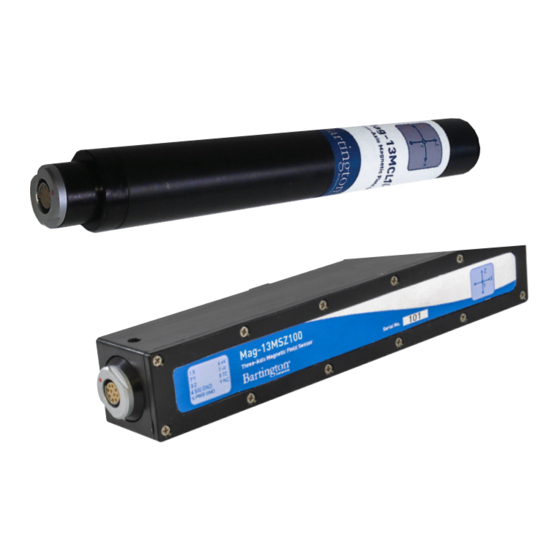
Table of Contents
Advertisement
Advertisement
Table of Contents

Subscribe to Our Youtube Channel
Summary of Contents for Bartington Mag-13
- Page 1 Operation Manual for Mag-13 Three-Axis Magnetic Field Sensors...
-
Page 2: Table Of Contents
BARTINGTON INSTRUMENTS Table of Contents About this Manual 1.1. Symbols Glossary Safe Use Introduction General Description Enclosures Compatible Power Supply and Data Acquisition Units Cables and Connectors 7.1. Cables 7.2. Mating Connectors Mounting 8.1. Mag-13MC 8.2. Mag-13MS Operation 9.1. Connector Pin Allocation 9.2. -
Page 3: About This Manual
Analogue output voltages Vx, Vy and Vz vary linearly with magnetic flux density. The Mag-13 series are an evolution of the Mag-03 range of sensors and feature a number of improvements. These include improved orthogonality error of the sensing coils, and an inbuilt test coil and temperature sensor. -
Page 4: General Description
6. Compatible Power Supply and Data Acquisition Units A number of other Bartington Instruments products will work with the Mag-13 as power supply and/or data acquisition units. These are listed in the product brochure and can be found at www. -
Page 5: Cables And Connectors
Although the Mag-13 is singled-ended, the cable connecting it to the power supply has a signal ground for each axis. The configuration of the cable pin out for the Mag-13 on the power supply side will require the power supply/signal conditioning unit to be set to the balanced mode to operate the Mag-13 correctly. -
Page 6: Mag-13Mc
The method of mounting will depend on the application and the enclosure. For details of the mounting arrangements for each sensor, refer to the product brochure and the relevant outline drawing on the Mag-13 product page. Note: The use of magnetic materials in the mounting arrangement must be avoided. Check... -
Page 7: Operation
Note: Adequate performance of the sensor cannot be guaranteed if used with non- Bartington Instruments products. Bartington Instruments cannot advise on the operation of third party products. See the product brochure for nominal current requirements. There is an additional current in proportion to the measured field, which is drawn from the positive or negative supply depending on the direction of the field. -
Page 8: Test Coil
Mag-13 outline wiring diagram 9.5. Test Coil The Mag-13 features a test coil which applies a magnetic field to all axes when activated. The corresponding changes in X, Y and Z output voltages confirm that all axes of the sensor are operational. -
Page 9: Temperature Sensor
Note: Do not place the sensor near to any equipment which may be affected by the very small local field produced by the sensor excitation. 10. Performance For detailed figures on the performance of the Mag-13 range of sensors, refer to the product brochure. 10.1. Noise The Mag-13 range includes different noise versions that are specified in the product brochure. -
Page 10: Excitation Frequency
All Bartington Instruments power supply and signal conditioning units have a filter to remove the breakthrough. Note: When using a non-Bartington Instruments power supply, it will be necessary to provide a filter to remove the breakthrough. Not doing so will lead to a higher noise level than that specified. -
Page 11: Disposal
/ electronic products. 13.1. Waste Electrical and Electronic Equipment (WEEE) Regulations Bartington Instruments Mag-13 sensors comply fully with Restriction of the Use of Certain Hazardous Substances in Electrical and Electronic Equipment (RoHS) and WEEE Regulations current at the time of printing. - Page 12 The copyright of this document is the property of Bartington Instruments Ltd. Bartington® is a registered trade mark of Bartington Instruments Limited in the following countries: United Kingdom, Australia, Brazil, Canada, China, European Union, India, Japan, Norway and the...


Need help?
Do you have a question about the Mag-13 and is the answer not in the manual?
Questions and answers